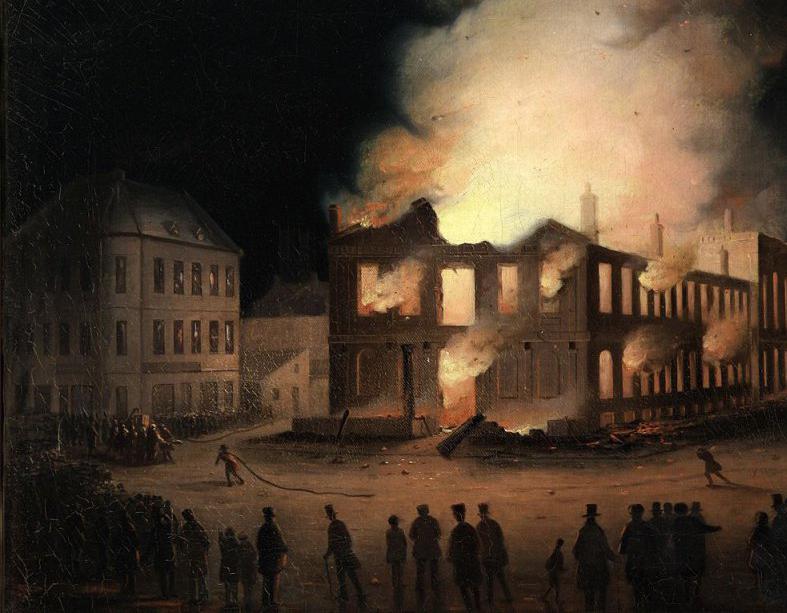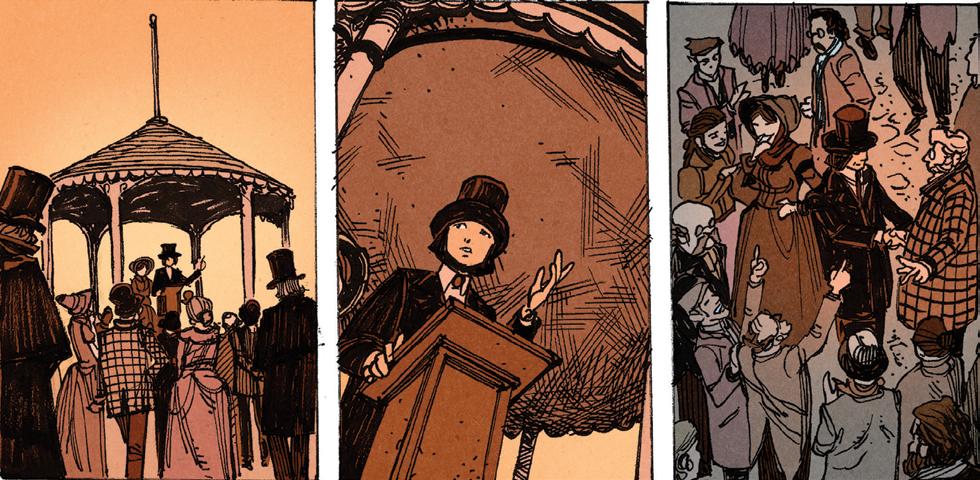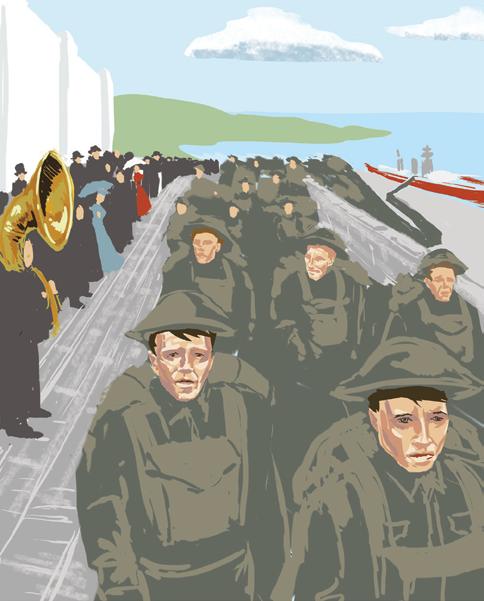
13 minute read
Curricula
Introduction Two remarkable individuals. Similar ages. Each with different backgrounds, upbringing, language, and culture. Both were lawyers, both were married, both felt the current political system needed reform. Both stood against violence and supported minority rights. Both opposed oppression, particularly of the large minority of Francophones in Quebec. Together they persevered, but in the beginning didn’t know each other. LouisHippolyte LaFontaine lived in Montreal and Robert Baldwin lived in Toronto. Both ran for public office and were elected. Both served in important roles in government. They formed a bond of friendship and professional connection that helped each support and lift the other to greater heights and achievements. Each remained selfless putting governance and the country first. Key Conce ts and Issues Students will learn about Robert Baldwin and LouisHippolyte LaFontaine and how they developed and implemented the political concept of Responsible Grades 9 to 12 Curricula Lesson 1: Super Heroes of Canadian Politics
Government. Students will explore the history of the period (from 1813 to 1851 approximately), an extraordinary time in the evolution of Canada, its democratic institutions and forms of government.
Duration:
3 to 4 classes
Materials Re uired:
• The Road to Confederation graphic novel • Computers or devices with Internet access • Materials needed for preparing presentations
Ex ectations/Outco es
The overall expectations listed below serve as an entry point for teachers. Teachers are encouraged to make connections to specific expectations in their region and grade.
Students will:
• Increase their knowledge of Canadian history; • Analyze the system of government of the day prior to the Reform party gaining political power; • Examine the impact of the reforms promoted by Robert and Louis-H and their importance to Canadian politics and governance then and today; • Explain how certain key events and personalities affected Robert and Louis-H, shaping their world view and governing their actions; • Demonstrate an understanding of the volatility in Canadian politics at the time; • Describe the relationship between Canada and Great Britain during the period 1800- 1850 approximately and the latter’s influence on Canadian life, society and government and; • Communicate their ideas, arguments, and conclusions using various formats and styles, as appropriate for the audience and purpose.
Curriculu
Links
Alberta and Northwest Territories Canadian History 20 Local and Canadian Geography Perspectives on Nationalism Understanding Nationalism Nationalism in Canada and the World
British Columbia and Yukon Territories Social Studies 10 Social Studies 11 Geography 12
Manitoba
History of Canada: A Foundation for Implementation Global Issues: Citizenship and Sustainability
New Brunswick
Canadian Geography 120 Social Studies 9, Canadian Identity 9
Saskatchewan
Social Studies 9 Canadian Studies 10 Social Studies 30 History 10 History 30
Quebec
History and Citizenship Education

Newfoundland/Labrador Social Studies 9 Canadian Geography 1202 Canadian History 1201
Nova Scotia
Canadian History 11 Geography 10 Global History 12
Nunavut
History, Geography, Environmental Science
Ontario
Canadian History since World War 1 Canadian and World Issues: A Geographic Analysis Canada: History, Identity and Culture
PEI
Social Studies 8 Canadian History 12
Background
Both Robert and Louis-H were raised in privileged circumstances. Although Louis-H’s father died when he was young, his mother re-married soon after. Both men excelled in school and earned law degrees before entering politics. Losing his father at a young age drew Louis-H to those he saw as father figures, men like Louis-Joseph Papineau, a political reformer and future rebel, as well as Robert’s father, William Warren, a medical doctor and elected member himself. Robert too, was very close to his father who mentored him throughout his early years and latter political career. Robert was a sensitive soul who embraced the ideals of Romanticism and believed in ideal love. He married his first cousin, Eliza, against her family’s wishes. Tragically, Eliza died after a difficult pregnancy leaving Robert to raise four children on his own. Louis-H and his wife, Adele, never had children. Temperamentally, Robert was not well-suited to public life. He was quiet and reserved and not a confident speaker. Louis-H, in his early years, remained both robust and combative, acting as a de facto bodyguard to Louis-Joseph Papineau who was attacked on a number of occasions by angry mobs during his rallies. Athletic and tough, Louis-H didn’t mind mixing it up when things got rough. But it was his intellect that won him plaudits such that he became one of the de facto leaders of the Reform movement in Lower Canada (Quebec). Robert also held his beliefs passionately and became a man dedicated to public life and improving the governance of Canadian society so that is was more supportive of and accountable to its citizens.
Throughout Canadian history, we see strong characters emerge who contribute significantly to society via public life. Adjacent to the period in which Robert and Louis-H lived, we have individuals like Sir Wilfrid Laurier and members of the Canadian Suffragist movement like Emily Stowe, Nelly McClung, Flora MacDonald Denison, and others. These individuals and others were of strong moral character and powerful beliefs that guided them through a difficult process to achieve their goals.
Have students discuss in class the qualities that make up leadership and even more importantly, what sort of moral compass is required? Divide the class into teams for the purposes of discussion. Are students able to isolate or identify why these characters followed this path (with the focus on Robert and Louis-H) and what traits made a difference in their lives? Or was there a particular event that propelled them further than most? Without the intervention of Robert and Louis-H, have students surmise or imagine what sort of Canada might have resulted. Would it be radically different from what we know today? If so, how? If not, why not? Each team will present their findings to the class in an oral presentation.
Ste T o: Creating a Pro ile
Have students research and write a profile of one of the following who influenced Robert or Louis-H at any point during their lives and whether this influence had a positive effect on their careers:
• William Warren Baldwin • Louis-Joseph Papineau • Lord Elgin • Robert Baldwin Senior • George Etienne Cartier • Eliza Baldwin • William Lyon Mackenzie • Sir Francis Bond Head • Adele Berthelot • Lord Durham • Joseph Howe • Lord Sydenham • Augustin (Austin) Cuvillier • Sir Charles Bagot • Sir Charles Metcalfe • Egerton Ryerson
The profiles will be handed in to the teacher for assessment.
Ste Three: Bringing a Character to Li e
The characters listed in Step Two all played some role in either Robert or Louis-H’s personal and/or professional life and development. Yet, each was a complete human being with a full life of their own. Have students, individually, select one of the characters for the purpose of bringing that character to life. This may be done in the form of a character sketch, a short scene written in play form, a short scene or monologue performed or acted out in front of the class, a series of sketches or illustrations (could be in graphic novel format), a formal presentation, poem, song, PowerPoint, and so on. Something significant about the character should be emphasized or brought out in the presentation, no matter what format it will take. Whatever the format selected, either written or oral, shall be assessed by the teacher.
Ste Four: Cul inating Activity
Have students select an individual from the following list: Mao Tse Tung, Sir Winston Churchill, Charles de Gaulle, Mahatma Gandhi, Vladimir Lenin, Nelson Mandela, Golda Meir, Helmut Kohl, Benito Mussolini, Anwar Sadat, Martin Luther King, or Juan Peron.
Students will research the individual they have selected and write a paper concerning the impact and influence that individual had on their country. What role did they play and how important was it to the country’s evolution? What are the specific factors? If possible, students will highlight a time line of the development of that individual’s career. Is it then possible to compare the individual selected to either Robert or Louis-H, in terms of the role each played and the importance in the development of the country? Once these profiles have been completed, they will be presented orally to the class.
• Although it wasn’t really given a name at the time, Robert and Louis-H adhered to the principles of passive resistance, for the most part, in the face of violence. Explain the concept of passive resistance, how it works and notable campaigns globally where this concept was put into action. • Robert believed in the Romantic concept of ideal love. After his wife Eliza, died at the young age of 25, Robert mourned her for the rest of his life. He carried her letters with him at all times and spent the day in mourning on the anniversary of her death. Explain the concept of ideal love and what it means and its influence on Robert. • Politics during Robert and Louis-H’s time could be rough and tumble, even dangerous and violent. Many times, each of them confronted violent situations and/or were threatened with violence. What factors led to outbreaks of violence during political processes and campaigns? What purpose did it serve? Was it a successful tactic? If so, how was it successful? If not, why did it fail? Students will develop role plays based on the scenarios presented in the graphic novel, Road to Confederation, and the specific sections that chronicle Robert and LouisH’s political careers. Have students work in small teams to develop these role plays and present them to the class. The teacher may list examples of situations taken from the graphic novel. • The student debate. Have students form into debating teams. Here is the question to be debated: Be it resolved that the British colonial system worked well in colonies such as Canada and that the population benefitted from this approach. One team shall take the Pro side and the other, the Con side. Formal debating rules will be followed: http:// www.edu.gov.mb.ca/k12/cur/socstud/frame_ found_sr2/tns/tn-13.pdf. Those class members not on the two teams will act as judges and select the winner of the debate. The teacher shall act as moderator. • Literary Assessment: Each student will write a critical review of Road to Confederation graphic novel. The review will run up to two pages and will look at elements such as plot, character, illustrations, quality of illustrations and the effectiveness in the way the story was told and depicted. Did the characters appear realistic? Do Robert and Louis-H come across as ‘real’ people? Could the reader identify and empathize with the characters? The reviews will be handed in/submitted to the teacher for assessment.
Assess ent and Evaluation
Student Evaluation Questions Specific to the Lesson Plan
Before (Pre-Implementation) • Do students have a general understanding of the principles of Responsible government? • Do students have a clear understanding of the significance of the early influences on Robert Baldwin and Louis-Hippolyte LaFontaine? • Do students have any prior understanding of Robert and Louis-H’s importance to Canada’s history? • Are students familiar with the history of the British Empire, how widespread and powerful it was and what role it played in ruling Canada among other colonies?
After (Post-Implementation) • Students will describe the principles of Responsible Government and list their significance. • Students will reflect an understanding of the importance of Robert Baldwin and LouisHippolyte LaFontaine who helped establish democratic governance in the Canadian political process. • Students will reflect on, and explain their ideas about the legacy of Robert Baldwin and Louis-Hippolyte LaFontaine.
Before (Pre-implementation) • Do you have a general understanding of the importance of the principle of Responsible government? • Do you have a clear understanding of the significance of the relationship between Robert Baldwin and Louis-Hippolyte LaFontaine? • Do you have any prior understanding of Robert and Louis-H’s early influences? • Are you familiar with the concept of passive resistance? After (Post-Implementation) • Describe Robert and Louis-H’s early influences and their impact. • Have a clear understanding of Robert and Louis-H’s contributions to Canadian politics and history. • Understand why Robert and Louis-H laid the groundwork for a modern, democratic Canada.

Discussion
Content
Written Work
Presentation
Group Work Level 1 Level 2 Level 3 Level 4
Student participated poorly in the teacherdirected discussions Student participated adequately in teacher-directed discussions Student participated actively in the teacher-directed discussions Student participated exemplarily the teacher-directed discussions
Student demonstrated limited understanding of concepts, facts, and terms Student demonstrated some understanding of concepts, facts, and terms
Student’s written report was confusing, poorly structured, and had many grammatical errors Student’s written report was generally clear and had some structure, but numerous grammatical errors
Student’s presentation was confusing, lacked emphasis and energy, and resulted in no discussion Student’s presentation was generally clear, but lacked energy and emphasis, and resulted in little discussion
Students made a minimal contribution to the group; very little cooperation Students made some contribution to the group, but cooperation was superficial Student demonstrated considerable understanding of concepts, facts, and terms
Student’s written report was clear and well-structured, but had a few errors Student demonstrated thorough understanding of concepts, facts, and terms
Student’s written report was very clear, well-organized, and had virtually no errors
Student’s presentation was clear, vibrantly presented, and resulted in a good discussion
Students made a considerable contribution to the group, with a good level of cooperation Student’s presentation was very clear, enthusiastically presented, and resulted in engaging discussion
Students made a significant contribution to the group, with an excellent level of cooperation
Step One
Step Two
Step Three
Step Four Level 1 Level 2 Level 3 Level 4
Student demonstrated a limited understanding of the significance of Baldwin and LaFontaine’s contribution to Canada’s history Student demonstrated a basic understanding of the significance of Baldwin and LaFontaine’s contribution to Canada’s history Student demonstrated a good understanding of the significance of Baldwin and LaFontaine’s contribution to Canada’s history Student demonstrated a thorough understanding of the significance of Baldwin and LaFontaine’s contribution to Canada’s history
Student demonstrated a limited understanding in their writing on the topic of a Baldwin and LaFontaine influencer Student demonstrated a basic understanding in their writing on the topic of a Baldwin and LaFontaine influencer Student demonstrated a good understanding in their writing on the topic of a Baldwin and LaFontaine influencer Student demonstrated a thorough understanding in their writing on the topic of a Baldwin and LaFontaine influencer
Student demonstrated minimal understanding of the character profile and a limited effort in the presentation Student demonstrated adequate understanding of the character profile and a satisfactory effort in the presentation Student demonstrated significant understanding of the character profile and an active effort in the presentation Student demonstrated thorough understanding of the character profile and a substantive effort in the presentation
Student demonstrated limited insight into the individual they selected for a profile and the impact on their country of origin Student demonstrated basic insight into the individual they selected for a profile and the impact on their country of origin Student demonstrated good insight into the individual they selected for a profile and the impact on their country of origin Student demonstrated thorough insight into the individual they selected for a profile and the impact on their country of origin
Explore the Life and Times of Canada's first Francophone Prime Minister

Sir Wilfrid’s story is brought to life through compelling images that illustrate his life from childhood to his twilight years. Follow one ofthe most revered politicians in Canadian history and the highs and lows of his celebrated career as well as his common humanity.
Key People and Themes
Sir Wilfrid’s family life; Francophone politics in Quebec and on the national stage; The tragedy of Louis Riel; the Manitoba Schools Crisis; Outbreak of the First World War; and Mandatory conscription.
Teacher Resources

Comprehensive suite of curriculum-connected resources and lesson plans smoothing the way for classroom implementation. Recommended for teachers and students in Grades 9-12. Available in English and French.
SIGN UP TODAY AT SIRWILFRIDLAURIER.COM

October 1 4, 1 91 4 Canadian Expeditionary Force lands at Plymouth


theshatteredground.com SIGN UP TODAY, IT’S FREE!






